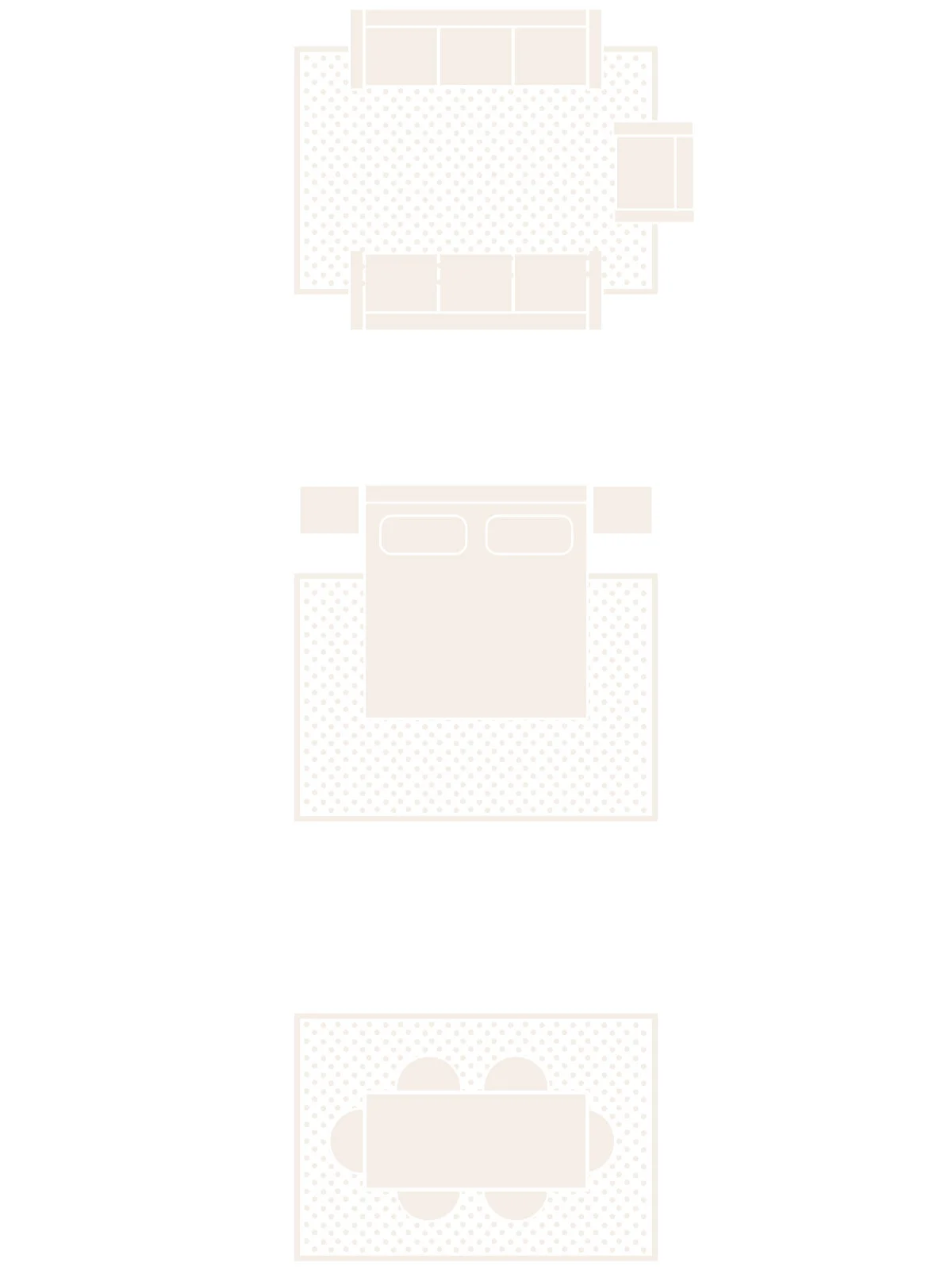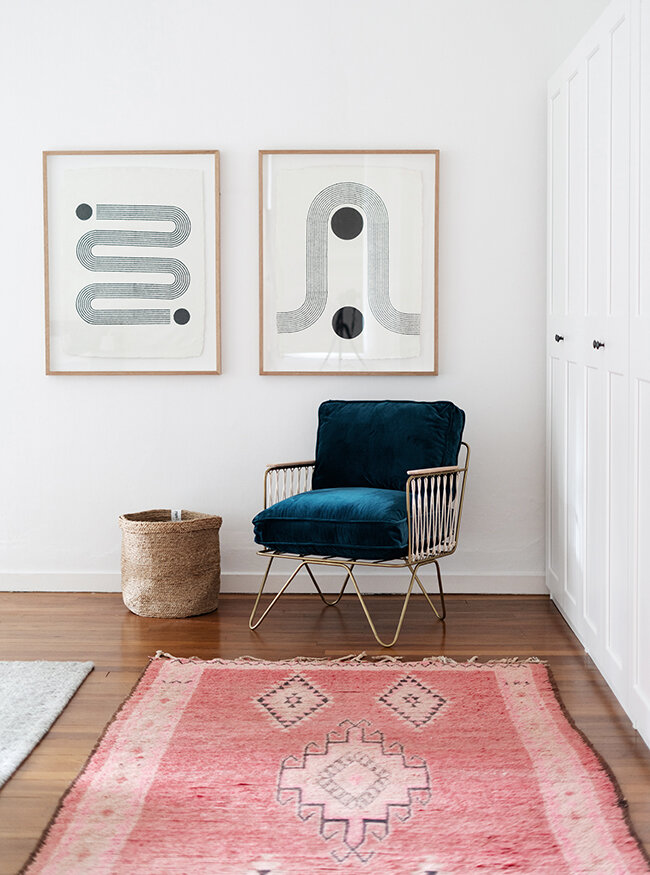Guide to Buying a Rug
If you follow me on instagram you may have seen that each Monday I offer interior styling advice to anyone who is wanting to improve an area of their home. I have been running this for a few weeks now and there are two recurring styling issues that have emerged - one is placement, or lack, of art and the other is rugs. It's understandable, these two homeware items can be expensive to buy and they also require more consideration than say a new vase or some cushions. So I can see why there may be a resistance, in general, to figuring these elements out.
By and large the biggest issue facing the rooms I am consulting on is that there is either no rug, or the rug is too small for the space.
THINK OF A RUG AS LAYING THE FOUNDATION FOR THE ROOM
A correctly sized rug provides a foundation for the room. It is the one piece that will tie all of your furniture together and help to create cohesion. Without a rug, or the wrong sized rug, furniture can look disjointed and a bit plonked in place. In addition, a room without a rug can often have a temporary "only just moved in" feel. Now...this isn't always true. If, for instance, you are lucky enough to live in a home with stunning floors - think European oak herringbone floorboards, then perhaps you won't want a rug. But for the rest of us a rug can also help to hide an unattractive floor. And let's not forget that rugs provide a sense of softness underfoot which is always lovely.
Choosing a rug size is actually pretty easy. There are a couple of considerations, but as most rugs come in standard sizes, choosing the right one can be quite straight forward.
Find the Ideal Size
Living Room: Look for a rug that (as a minimum) is big enough to allow the front legs of your furniture to all sit evenly on the rug. Each sofa or armchair should have it's front legs on the rug by a minimum 15cm (that is, at least 15cm of the rug is under the furniture - hopefully it's more). Generally, this will be a 3x4m rug.
For a smaller rectangle shaped living room where you only have space for one sofa and an armchair, then a 2x3m rug will generally be the right size.The alternative is to have a rug large enough that all pieces of furniture sit on the rug (front and back legs). This will usually mean a custom sized rug - typically 4x4m in size.
Bedroom: In the bedroom, have your rug be large enough to fit 3/4 way under the bed with a 1/3 of the rug still visible at the foot of the bed. Depending on the overall size of your bedroom you can pull the rug up more or less- but use this as a general guide. What you don't want is a skinny strip of rug showing at the foot. Try and keep the rug looking in proportion and even with the furniture. For most king sized beds, a 2.5x3.5m rug is ideal.
Dining Room: Don't discount adding a rug into the dining room. If you have little ones (or big ones!) who might drop a lot of food perhaps it's not right for you. But as with other rooms in the house, a rug in the dining room will help to anchor the space. Look for a rug that is flat woven and won't catch when a chair is being pulled in and out, and in terms of size, go for a rug that provides enough space so that when the chairs are pulled out and sat on, the rug is still underneath all the legs.
Consider Where the Rug will Go
Now that you have determined the best rug size for your room, consider the foot traffic your rug will receive. In high foot traffic areas such as living rooms, choose a rug with a tighter weave that will not pull and shed, whereas in a bedroom that has significantly less foot traffic, choose a rug that is soft with perhaps a deeper pile. For rugs in dining rooms, choose a flat weave and consider how easy cleaning the fabric of the rug will be.
You may also want to consider how the rug will be used. In a living room you may wish to be able to sit on the rug and it may be an area for little ones to play, in which case I highly recommend a thick underlay - particularly if you have chosen a flatter weave rug. A good quality underlay will extend the wear of your rug and will also stop it from bunching and moving about, so it's worth investing in one. Buy one from a carpet supplier and have it cut to size.
Budget
If you are not able to afford the rug size that you need, consider alternatives. One trick I often use is to place two Lohal rugs from Ikea side by side to create one larger looking rug. The Lohal rug does not have an obvious finish at it's edges which makes it perfect for disguising where one rug starts and the other rug ends. Sisal and other natural woven fibre rugs are similarly priced to wool blend rugs - with pure wool and wool silk blend rugs generally more expensive.
Pattern or Plain
When choosing a rug for your room you first need to decide whether you want something with a pattern or something plain. For larger area rugs I prefer to go with a plain textured rug, or a textured rug with a subtle tone-on-tone pattern (such as the Armadillo & Co ones) and save the more colourful patterned rugs as smaller occasional rugs in entrances and hallways.
Choosing a plain textured rug will stand the test of time and see you through changes in the other colours you use in your room (different cushions, a change in bedlinen colour etc). Go for neutral tones in creams, greys or beiges that will always provide a solid foundation for your more interesting homeware choices.
my favourite neutral area rugs







